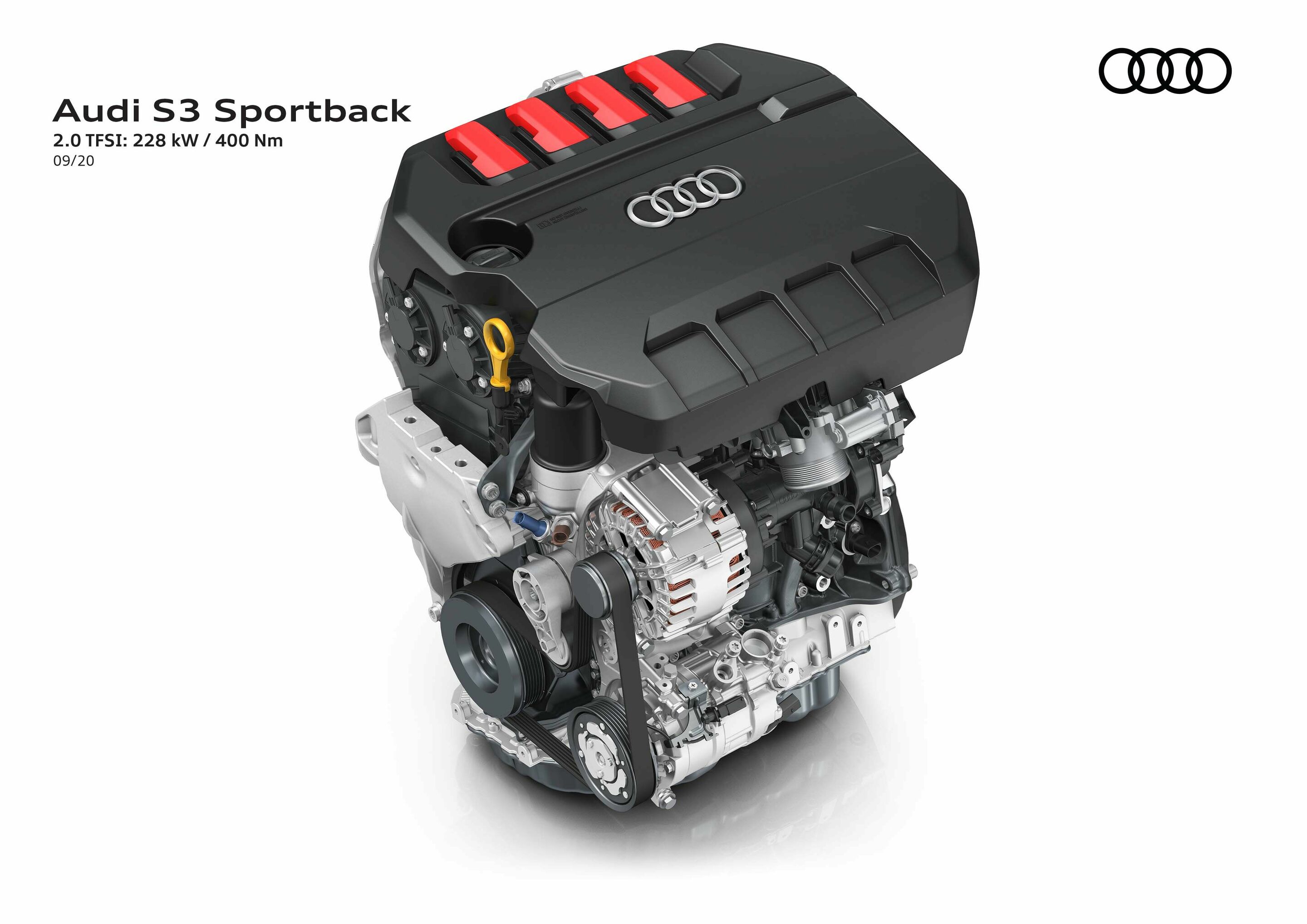Developed for performance: the 2.0 TFSI
Back to overviewProducing 228 kW (310 PS) of power and 400 Nm (295.0 lb-ft) of torque, the 2.0 TFSI in the new S3 models is a real powerhouse. It delivers its maximum torque across a broad range of between 2,000 and 5,450 rpm. The rated power output comes in where this ends, remaining constant up to 6,500 rpm. The two-liter engine accelerates both models from 0 to 100 km/h (62.1 mph) in 4.8 seconds on the way to an electronically governed top speed of 250 km/h (155.3 mph).
The high-performance four-cylinder engine unites state-of-the-art technologies. The injection system builds up 350 bar of pressure and ensures good mixture generation. This is supported by the Audi valvelift system and the two adjustable camshafts. Thermal management also helps to ensure high efficiency – with a rotary slide module that precisely controls the flow of the coolant through the engine and the exhaust manifold that is integrated into the cylinder head. Both of these features help to ensure that cooling water heats up quickly following a cold start, shortening the phase of increased friction losses due to cold oil.
The large turbocharger provides charging pressures of up to 1.8 bars (relative), while an intercooler greatly reduces the temperature of the compressed air. Because cooler air contains more oxygen, this improves the filling of the combustion chambers. When the driver uses the Audi drive select system to select dynamic mode, the response time of the engine becomes even more spontaneous and its sound even more sonorous.
| Audi S3 | Sportback | Sedan |
| Displacement in cc | 1,984 | 1,984 |
| Max. power output in kW (PS) at rpm | 228 (310) from 5,450–6,500 | 228 (310) from 5,450–6,500 |
| Max. torque in Nm at rpm | 400 (295.0 lb-ft) from 2,000–5,450 | 400 (295.0 lb-ft) from 2,000–5,450 |
| Top speed in km/h | 250 (155.3 mph) | 250 (155.3 mph) |
| Acceleration 0–100 km/h (0–62.1 mph) in s | 4.8 | 4.8 |
| Fuel consumption (combined) in l/100 km* (18"–19") | 7.4 (31.8 US mpg*) | 7.3–7.2 (32.2–32.7 US mpg*) |
| Combined CO2 emissions in g/km* | 170–169 (273.6–272.0 g/mi*) | 166–165 (267.2–265.5 g/mi*) |
| Drive | quattro drive | quattro drive |
| Transmission | Seven-speed S tronic | Seven-speed S tronic |
The seven-speed S tronic, which comes as standard in the new S3 models, boasts lightning-fast gear shifts. The selector lever, which is designed as a compact shifter, lets the driver control shifting gears by pushing and pulling. The dual-clutch transmission can be switched to D and S modes or controlled directly using the paddles on the steering wheel that are provided as standard. When Audi drive select is set to “efficiency,” the clutch is disengaged and the freewheeling function is activated as soon as the driver takes their foot off the accelerator.
Like all Audi S models, the new S3 Sportback and the new S3 Sedan are equipped with the permanent quattro all-wheel drive as standard. At its heart is an electro-hydraulic multi-plate clutch with electronic control, which distributes the drive torque between the front and rear axles fully variably depending on the driving situation. The clutch, which is located at the end of the prop shaft for weight distribution reasons, belongs to a new generation. It is around one kilogram (2.2 lb) lighter than its predecessor while offering increased efficiency thanks to various details such as bearings and lubrication.
The management of the quattro clutch combines dynamic performance with stability and efficiency. During normal driving, the majority of the torque is directed to the front wheels – the electric motor in the multi-plate clutch that drives the axial piston pump is temporary deactivated, and the multi-plate clutch is fully or almost fully open. When moving off or when there is low traction on the front axle, this electric oil pump is activated, and the plate package is pushed together with up to 40 bar of hydraulic pressure. The stronger the pressure, the more torque is directed to the rear axle – up to 100 percent when the multi-plate clutch is fully closed.
The clutch can already begin sending a portion of the torque to the rear axle when the driver turns sportily – as soon as the driver accelerates, the S3 is literally pressed into the corner. During load changes, the distribution of torque allows precise turning into the bend, which further increases driving dynamics. Handling is rounded off by the wheel‑selective torque control and its finely tuned brake interventions. If the wheels on the inside of the curve lose grip when cornering at high speed and threaten to slip, they are braked using gentle impulses.
The control of the multi-plate clutch is integrated into the modular dynamic handling control. This central system collects data from all components that are relevant for transverse dynamics and manages the quick and precise interplay between them. The modular dynamic handling control computes the optimal settings for the quattro clutch, the Electronic Stabilization Control, and the (optional) adaptive dampers predictively based on steering movements. The result: Handling that is even more sporty and nimble.
All terms in blue in the text are explained in detail in the technology lexicon at www.audi-mediacenter.com/en/technology-lexicon.
The equipment, data and prices stated here refer to the model range offered for sale in Germany. Subject to change without notice; errors and omissions excepted.
